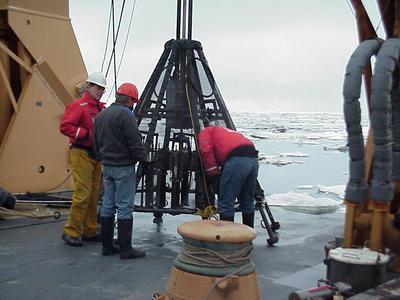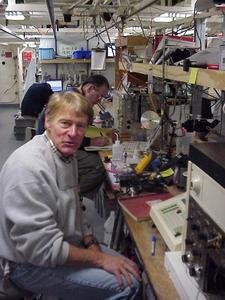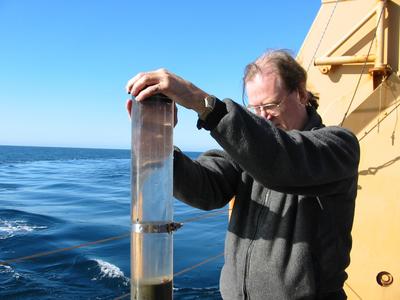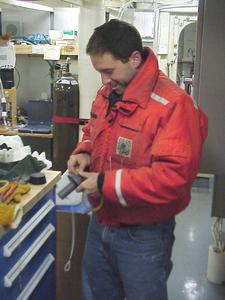
|
|
7 August, 2002
As we move out along the East Hanna Shoal transect, our work time hours
shift. Because stations don't take 24 hours when they are shallow, our
bottom sampling times moved from 2 AM to 10 PM to last night's work at 7 PM.
It's often difficult to remember what day it is and whether it is AM or PM!
As always, there are people in the lab at all times. The sampling and
processing work always comes first. Meals and sleep follow after the work
is done. I find that my journal writing schedule depends on my station
schedule. When I have an early morning station (midnight or soon after) I
try to get the journal written before I start the station. When the station
comes soon after dinner, I usually finish my station work and write the
journal in the morning. Yesterday (the 7th) I gathered information for my
journal during the afternoon and sampled sediments after dinner. I'm now
writing my journal on the morning of the 8th. For all that time, John
Christenson has been awake working on his sampling procedure and the
processing of his samples! It's that work that I'm going to tell you about.
Although I have said that we are always last at every station, that's not
completely true. We go at the end because we muddy the water so much when
we sieve out our van Veen grab samples. But, there is one more sediment
group on board. (Laura and Karl occasionally sample sediments with their
box core, but that is not the main focus of their work.) They are the ones
that use the really big corer called the multicore. It's tall enough that
they need a step ladder to hook it up to the cable that lowers it into the
water. It takes eight cores at a time, each one taller and narrower than
the ones we get with the Haps core. Allan Devol, John Christensen and Jason
Masters make up this team. Allan is a professor of oceanography at the
University of Washington in Seattle where Jason is an oceanographer. John
is a research scientist at the Bigelow Laboratory in Booth Bay Harbor,
Maine. Their work involves the denitrification rate. Let me give you some
background, tell you how they sample, and try to show where it all fits into
the big picture.
Nitrogen is a gas that exists in the air we all breath. It's also a very
important element for plants, but they can only use it when it is in a
different form (i.e. nitrate, nitrite, ammonia). The process of changing
nitrogen gas into a form that plants can use is called nitrogen fixation.
The amount of fixed nitrogen is very important for the plants
(phytoplankton) in oceans. It can be a limiting factor for the
phytoplankton which means that they can't grow if there's not enough fixed
nitrogen. Fixed nitrogen can be added to the water by nitrogen fixing algae
and it can be removed by a process called denitrification (the prefix de
means to take away) in which nitrate (the fixed nitrogen) is changed back to
nitrogen which escapes into the atmosphere. Most of the denitrification
happens in the sediments of the shelf and the slope for a number of reasons.
First of all, the amount of oxygen is very low in the sediments. That's
because there is little circulation to them up and because the process of
breaking down the dead material (decomposition) there uses up oxygen. When
the amount of oxygen is low, bacteria in the sediments begin to use nitrate
the same way other organisms use oxygen. When they do, they convert it to
nitrogen gas that escapes into the water and eventually into the atmosphere.
That's denitrification. This all happens mostly on the shelf and the slope
because that's where most dead material settles to the bottom.
That's the background; here's the question John, Allan and Jason are trying
to answer. Some scientists think there is more denitrification than
nitrogen fixation in the ocean. If you understand the process outlined
above, you'll realize that this means the oceans are losing more nitrogen
than they are getting. (Remember that the ocean plants, the phytoplankton,
need nitrogen.) There are other scientists who think that the nitrogen
cycle (fixation and denitrification) is balanced. There is simply not
enough data to know for sure which one is true. This is extremely important
here in the Arctic Ocean because, although the Arctic Ocean makes up only
10% of the world's oceans, it contains 25% of the world's continental shelf
and slope area. Whether the cycle is balanced or the Arctic Ocean is losing
more nitrogen than it is getting is important if we begin to think of global
climate change.
How does this team work? First they collect eight bottom cores at a time
with the multicore. They then incubate (put them in an environment where
things can grow naturally) for 24 - 48 hours. After that they measure the
change in oxygen concentration, the change in nitrogen concentration, and
the amount of nutrients present. To do all this they use a gas
chromatograph, a mass spectrometer, or tiny oxygen electrodes. Each method
checks the data in a slightly different way. They then take another one of
their core samples and centrifuge it. Basically that means that they spin
the sediments at high speed so the heavier mud stays on the bottom and the
water remains on the top. Almost 90% of the sediments is water! They then
analyze the remaining water for nutrients. In addition, John analyzes that
water and the water from the incubated cores for CO2 (carbon dioxide). That
gives them an idea of the activity that can take place in the sediments.
They will also do a series of measurements on the remaining mud.
John also adds a substance called potassium bromide to the water over the
incubated cores. The concentration of the potassium bromide will change
based on the amount of animal activity that is taking place. It will
diffuse into the sediments or be 'pulled into" the sediments by the activity
of the animals in the mud. This last part is called macrobenthic irrigation
(macro = large, benthic = animals on the bottom). When lots of animals are
present, there's lots of exchange. And, to tie it all together, when lots
of animals are present, and there's lots of exchange, that means there's
lots of denitrification! Everything goes back to the central question.

<> This is the large multicore that John, Allan and Jason use to grab eight core samples at one time.

<> Allan Devol, a professor at the University of Washington is working with John and Jason to try to determine the rate of denitrification in this part of the Arctic Ocean (see journal for an explanation).

<> John Christenson is a professor at the Bigelow Laboratory in Maine. Here he is on deck (on a previous, much nicer day) processing one of the core samples.

<> Jason Masters works with John and Allan to look at the denitrification rate. One of his jobs is to run the mass spectrometer.
Contact the TEA in the field at
.
If you cannot connect through your browser, copy the
TEA's e-mail address in the "To:" line of
your favorite e-mail package.
|
